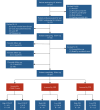The risk of malnutrition as a predictor of arrhythmia recurrence after catheter ablation in patients with paroxysmal non-valvular atrial Fibrillation and heart failure with preserved ejection fraction
- PMID: 39888955
- PMCID: PMC11785320
- DOI: 10.1371/journal.pone.0317721
The risk of malnutrition as a predictor of arrhythmia recurrence after catheter ablation in patients with paroxysmal non-valvular atrial Fibrillation and heart failure with preserved ejection fraction
Abstract
Background: Malnutrition presents a significant challenge in managing patients with atrial fibrillation (AF) and heart failure with preserved ejection fraction (HFpEF), yet its impact on AF recurrence after catheter ablation in this population remains unclear.
Methods: We conducted a retrospective analysis of 204 patients with paroxysmal non-valvular AF and HFpEF who underwent radiofrequency or cryoballoon ablation. Risk of malnutrition as assessed using three screening tools: the Controlling Nutritional Status (CONUT) score, Prognostic Nutritional Index (PNI), and Nutritional Risk Index (NRI)]. We examined the relationship between risk of malnutrition and AF recurrence post-ablation.
Results: After a mean follow-up period of 11.2 ± 1.8 months, 43 patients (21.1%) experienced AF recurrence. Despite being classified as overweight or obese based on body mass index, many patients were at risk of malnutrition according to the CONUT score, NRI, and PNI. Adjusted analyses showed that higher CONUT scores (HR: 10.132; 95% CI: 2.545-40.336; P = 0.001), lower NRI (HR: 22.734; 95% CI: 6.399-80.776; P < 0.001), or lower PNI (HR: 9.469; 95% CI: 3.232-27.739; P < 0.001) were significantly associated with increased risk of AF recurrence. Restricted cubic spline regression revealed an inverted U-shaped relationship between the CONUT score and AF recurrence, and L-shaped relationships for both NRI and PNI with AF recurrence.
Conclusions: Systematic nutritional assessment is crucial in patients with paroxysmal non-valvular AF and HFpEF. High CONUT scores, low NRI, or low PNI serve as independent predictors for AF recurrence. Further large-scale randomized controlled trials are required to validate these findings.
Copyright: © 2025 Zhang et al. This is an open access article distributed under the terms of the Creative Commons Attribution License, which permits unrestricted use, distribution, and reproduction in any medium, provided the original author and source are credited.
Conflict of interest statement
The authors have declared that no competing interests exist.
Figures





Similar articles
-
Comparison of Catheter Ablation in Patients with Paroxysmal Non-valvular Atrial Fibrillation and Heart Failure with Preserved Ejection Fraction.Int J Med Sci. 2025 Jan 1;22(2):371-382. doi: 10.7150/ijms.103170. eCollection 2025. Int J Med Sci. 2025. PMID: 39781528 Free PMC article.
-
The impact of malnutrition on atrial fibrillation recurrence post ablation.Nutr Metab Cardiovasc Dis. 2021 Mar 10;31(3):834-840. doi: 10.1016/j.numecd.2020.12.003. Epub 2020 Dec 10. Nutr Metab Cardiovasc Dis. 2021. PMID: 33549446
-
Malnutrition in acute heart failure with preserved ejection fraction: clinical correlates and prognostic implications.ESC Heart Fail. 2019 Oct;6(5):953-964. doi: 10.1002/ehf2.12501. Epub 2019 Aug 10. ESC Heart Fail. 2019. PMID: 31400092 Free PMC article.
-
Atrial Fibrillation Ablation in Heart Failure With Reduced vs Preserved Ejection Fraction: A Systematic Review and Meta-Analysis.JAMA Cardiol. 2024 Jun 1;9(6):545-555. doi: 10.1001/jamacardio.2024.0675. JAMA Cardiol. 2024. PMID: 38656292 Free PMC article.
-
Meta-analysis of the Usefulness of Catheter Ablation of Atrial Fibrillation in Patients With Heart Failure With Preserved Ejection Fraction.Am J Cardiol. 2021 Mar 1;142:66-73. doi: 10.1016/j.amjcard.2020.11.039. Epub 2020 Dec 5. Am J Cardiol. 2021. PMID: 33290688 Free PMC article.
References
-
- Rahman A, Wu T, Bricknell R, Muqtadir Z, Armstrong D. Malnutrition matters in canadian hospitalized patients: malnutrition risk in hospitalized patients in a tertiary care center using the malnutrition universal screening tool. Nutr Clin Pract. 2015;30(5):709–13. doi: 10.1177/0884533615598954 - DOI - PubMed
MeSH terms
LinkOut - more resources
Full Text Sources
Medical

